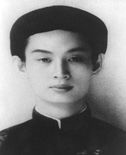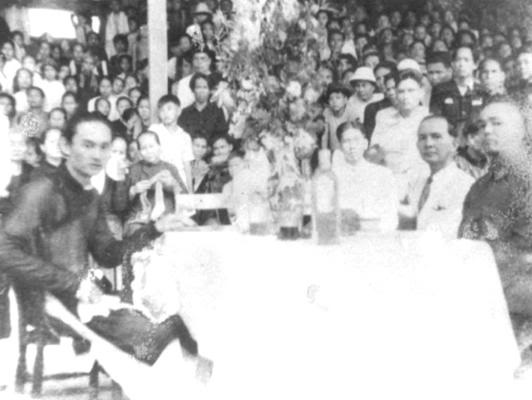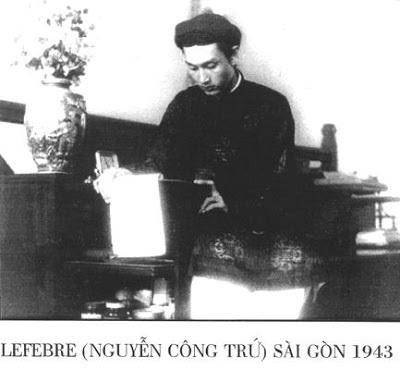PHẬT GIÁO HÒA HẢO
HARMONY BUDDHISM
Lord Master Huynh’s Concise Biography
The very venerable Huynh Phu So, deferentially called "Đức Thầy" or Master Huynh by His followers and Hoa Hao sympathizers, was the founder of Hoa Hao Buddhism. He was born at Hoa Hao Village, Chau Doc, South Vietnam, a province adjacent to the Vietnamese- Cambodian border, on 25 November, the year of Earth Goat (15 January 1920). He was the eldest son of His Eminence Huynh Cong Bo and Her Eminence Le Thi Nham, one of the prominent families best known for their generosity and credibility in the local community.
From 15 to 1̣́9, he never ceased to be in ill health. When He completed primary education, He had to leave school early for convalescence. However, He never entirely recovered whoever was His best treating physician, Oriental or Occidental.
In 1939, He proved fully Enlightened after a pilgrimage He initiated with His Father to the proper Thất Sơn ̣and Bokor Mountains, both famous for holiness and magnificence. On 18 May 1939, the Earth Rabbit Year, He launched His mission as a Messiah. He started with faith healing. He healed many hardly curable diseases, despite His incredibly simple methods, e.g., the use of tree leaves, freshwater, the yellow paper that flabbergasted both Oriental and Occidental physicians and warlocks.
While healing, He went preaching far and wide, and His speeches were characterized by great eloquence. Poets, writers, lawyers, and the like, who, on hearing His reputation, wanted to test His knowledge and skills and all acknowledged that He was supernatural.
He left behind an invaluable treasure in Vietnamese literature. Since 1939, He composed a lot of Stanzas, whose themes cover a wide range of issues, the most obvious among which is the impending world war with its devastating effects upon humankind. Therein, He urged people to repent and do good, fulfill their Four Great Debts of Gratitude, and cultivate virtues so that they may timely enter the Pure Land.
In the same way that He treated myriad patients in critical conditions with simple methods, He successfully awakened so many of His audience with His practicable and easily understandable teachings. Up to date, the collection of His Six Books of Stanzas, the yearly archives of hundreds of poems, proses, mantras, tinged with Vietnamese folklore, and, in cases, classics, still serve as the almanac for millions of Vietnamese faithful and Hoa Hao Buddhist sympathizers.
His writings are mainly in vernacular, concise, and engaging. In addition, He wrote prolifically, without drafting. Many eyewitnesses provided ample anecdotal evidence of Master Huynh's exemplary deeds that by far exceeded the expectations of His contemporaries on many planes. By following His greater biography, one can better find His miraculous theoretical and practical manifestation of His Mission Statement and the Sixth Booklet, in particular, and the whole Oracle collection, in general.
Even though Master Huynh's preachings are profound, they are efficient and adaptable to various audience levels for the time being. He is a great religious revolutionary. Before He launched His mission, Buddhism in Vietnam had long been stagnant and disoriented. Buddhism over the rest of the world was not much different. First, He simplified the rituals according to what Lord Master Sakyamuni Buddha initially taught. Then, He introduced a few innovations in practicing methods. It is owing to these renewals that, within a short period of time, He had about two-million followers in the South-Western region of Vietnam, and His influence continued expanding.
As His reputation had grown bigger every day, so did the authorities invent measures to clamp down on the Hoa Hao Buddhist movement. Thus, they placed Him under political surveillance at the Nhon Nghia commune, Can Tho. Here, He was even better known than before, prompting colonial authorities to institutionalize Him in the Cho Quan hospital (Saigon). Later, He was moved to Bac Lieu till 1942.
When the Japanese encroached on Indochina during the late Second World War, they transferred Him back to Saigon, where He stayed over at the Japanese Kempeitai headquarters. Here, He waited for the opportunity to assume the position of national÷level responsibility. Then, He composed a pair of sentences to express His ordeal.
"Zhang Xian returned to Han, but He was not Han's subject,
Guan Di, who lived in Cao Cao's camp, did not yet submit to him."
The Japanese wanted to ingratiate Him because they intended to win over the widespread support from His massive following, of which they could take advantage later. However, Master Huynh would be wise enough to never let them implicate Him in their preparations against the Allies. After the coup d'état of 9 March 1945, He kept a very reserved attitude as He had undoubtedly known in advance that the Japanese would sooner or later lose their war. Then, He made a humorous prediction: "The Japanese could not eat up the whole chicken." That was proven! The Year of Rooster perfectly matched 1945, which has finished no sooner than Japan's fate had been sealed. In 1945, 'Filled with compassion for masses on the verge of calamity,' He stood out for national salvation by setting up the Union of Buddhist Organizations to unify their faithful and the Alliance for Vietnam's Independence to campaign for national independence.
After the Japanese Emperor's unconditional surrender to the Allies, Vietnam had to spend an uncertain period. Vietnamese compatriots feared the old scenario of being enslaved with a new master. Thus, Master Huynh and politico-religious leaders established the National United Front to have a united voice with foreigners. However, this entity was annexed by the Viet Minh, for which Master Huynh himself was one of the first representatives in South Vietnam.
Given that Ho Chi Minh's impolitic policy through the Treaty of 6 March 1946 facilitated the re- colonialization of Vietnam, Master Huynh linked up with non-communist leaders to found the Front of Nationalist Allies. However, the masses enthusiastically supported this Front, which the dictatorial Viet Minh arbitrarily disbanded. The latter set up the Union of Vietnam's People to camouflage Third International's red nuance and cleanse the masses' memory from the bloody suppression by Communist generals in late 1945. In 1946, for the sake of unity among different strata of compatriots, He agreed to participate in the Administrative Commission as a Special Commissioner.
In the meantime, He linked nationalist fighters and all Hoa Hao Buddhists together under the Party for Social Democracy that He established on 21-09-1946 to foster social justice in a democratized Vietnam. He was a shrewd religious revolutionary and a highly talented political leader. Through His wording of the Party's Declaration and Programs, even His opponents and the most demanding critics should find one of the most progressive innovations and unsurpassed perspicacity.
He also sent His people overseas. He formed a coalition of fugitive nationalist revolutionaries to establish the National United Front. The Nationalist solution was also inspired by Himself and fugitive revolutionaries in undertakings that have so far existed. As His directions ran counter to the Communist doctrine and might lead to breaking down Atheism, therefore, the Communists had made any attempts to harm Him but to no avail.
By early 1947, in the Western region, Hoa Hao Buddhists protested the autocratic Viet Minh commissions for the dictatorial style of operation they imposed on their mass organization and management. To avoid fratricide, Master Huynh returned to South Western Vietnam in bona fide to calm down the Hoa Hao Buddhists while trying to reconcile them with the Viet Minh for the sake of effectively fighting the colonialist. But, on 25 February, Fire Pig (16 -04-1947), the Viet Minh attempted His life at Doc Vang Ha, Dong Thap.
Since then, no one heard any further from Master Huynh, but all Hoa Hao Buddhists hold the firm belief that the Communists had never succeeded in harming Him. And all His followers are convinced that their Master should return one day and in the greatest of His glory.
The following guidebook, "Essentials Guide to Practice," in the Vietnamese language, was one of His manuscripts published over 300 times, amounting to 800,000 copies. It is an excellent summary of all of what an Hoa Hao Buddhist needs to know in daily practice.
Hoa Hao Sacred Site, 1 January 1966,
The Central Religious Propagation Commission The Hoa Hao Buddhist Congregation (Term I, 1964 – 1966)
VÀI NÉT VỀ ĐỨC HUỲNH GIÁO CHỦ
Người sáng lập Đạo Phật-Giáo Hòa-Hảo là Đức Thầy Huỳnh- Phú-Sổ. Sanh ngày 25 tháng 11 năm Kỷ-Mùi (1919) tại làng Hòa- Hảo, tỉnh Châu-Đốc, một tỉnh xa xôi giáp biên-thùy Việt-Miên thuộc miền nam Việt-Nam.
Ngài là trưởng nam của Đức Ông Huỳnh-Công-Bộ và Đức Bà Lê-Thị-Nhậm; một gia đình trung-lưu, phúc hậu và nhiều uy-tín với nhân-dân địa-phương.
Thuở nhỏ, vừa học đến hết bậc tiểu-học thì đau ốm liên miên, nên Ngài phải rời nhà trường về dưỡng bịnh. Từ 15 đến18 tuổi, Ngài không lúc nào dứt được cơn đau và không một lương-y nào trị được.
Năm 1939, sau khi hướng-dẫn thân-phụ đi viếng các amđộng miền Thất-sơn và núi Tà-lơn - những núi non được nổi tiếng linh-thiêng hùng-vĩ - Ngài tỏ ra đại ngộ. Ngày 18-5 Kỷ-Mão 1939 Ngài chính-thức mở Đạo. Bắt đầu là công việc chữa bịnh. Ngài chữa lành được các chứng hiểm-nghèo với phương-pháp thật giản đơn là chỉ dùng lá cây, nước lã, giấy vàng, khiến cho các Bác-sĩ Tây-y, các dược-sư Đông-y lẫn các danh gia phù-thủy đều phải kinh-dị.
Song song với việc chữa bịnh, Ngài thuyết-pháp thao thao bất tuyệt. Nhiều thi-sĩ văn-gia hoặc luật-gia nghe tiếng, đến chất vấn, đều phải nhận Ngài là một bậc siêu-phàm.
Cũng từ năm 1939, Ngài sáng-tác thật nhiều kệ-giảng, nộidung tiên-tri chiến-cuộc sẽ tràn lan, nhân-loại sẽ điêu-linh và kêu gọi mọi người nên bỏ dữ về lành, thực-hành tứ-ân, trau-giồi thiền tịnh để trở thành thiện-nhân trong xã-hội và tiến đến sự nhập diệu cõi đạo.
Nhìn qua công-đức giảng dân cứu chúng, người ta thấy Ngài chữa được hằng vạn chứng hiểm nghèo, thuyết-Pháp hằng ngàn lần trước đại-đa thính-chúng và sáng-tác sáu quyển Kệ-Giảng cùng với hằng trăm bài thi ca, văn, chú có giá-trị siêu-việt.
Văn-chương của Ngài cực kỳ bình-dân nhưng rất hàm-súc hấp-dẫn. Ngài viết không cần giấy nháp.
Giáo-Pháp của Đức Giáo-Chủ tuy cao-siêu nhưng không kém phần thực-tế, có thể áp-dụng cho bất cứ nơi nào trên thế-gian. Ngài là một nhà đại cách-mạng tôn-giáo. Vì trước khi Ngài ra đời, Đạo Phật Việt-Nam bị đình-đốn sai lạc, và Đạo Phật Thế-giới chưa nói tới việc canh tân. Ngài đã cắt bỏ tất cả những nghi-lễ phiền toái mà nguyên-căn không phải của Đức Thích-Ca chủ-trương, đồng thời còn canh-tân nhiều điểm trong phương-pháp thực hành đạo Phật mà trước kia không hề có.
Nhờ Giáo-Pháp thích-thời đó nên chỉ trong một thời gian ngắn, Ngài thu-phục được hai triệu tín-đồ tại miền Nam Việt-Nam và ảnh-hưởng mỗi lúc càng lan rộng thêm ra.
Vì Ngài được thiên-hạ quá hoan-nghinh nên nhà đương cuộc bắt đầu để ý đến sự bành trướng dị thường của phong trào tôngiáo Phật-Giáo Hòa-Hảo, nên một biện pháp chánh-trị đã được đem ra thi hành và Ngài phải bị quản thúc tại làng Nhơn-Nghĩa (Cần thơ).
Ở đây, Ngài lại được người ta tôn sùng hơn trước nữa, làm cho nhà cầm quyền phải đem Ngài an-trí tại nhà thương Chợ Quán. Sau đó, Ngài lại bị dời về Bạc-Liêu đến năm 1942.
Khi người Nhựt nhúng tay vào thời cuộc Đông-dương trong hồi thế-giới chiến-tranh kỳ nhì, họ cưởng bách đem Ngài về Sài Gòn thì Ngài buộc lòng tá-túc tại cơ sở Hiến binh Nhựt để chờ đợi thời cơ thuận tiện ra gánh vát việc nước nhà. Khi đó Ngài có làm câu đối để diễn tả hoàn-cảnh của mình :
« Trương Tiên tá Hớn phi thần Hớn,
Quan đế cư Tào bất đê Tào » (1)
Sở dĩ người Nhựt muốn thi ân với Ngài là vì họ muốn gây cảm tình với khối tín đồ khổng lồ của Ngài để sau nầy có thể lợi dụng. Nhưng đã là một người sáng suốt thì Ngài đâu có để cho bọn Nhựt lôi cuốn trong việc chuẩn bị của họ chống Đồng-minh.
Sau cuộc đảo-chánh mùng 9 tháng 3 dương-lịch 1945, Ngài giữ một thái độ hết sức dè dặt vì Ngài biết chắc chắn rằng người Nhựt thế nào cũng thất trận. Lúc đó, Ngài nói một lời tiên-tri rất hài hước « Nhật-bổn ăn không hết con gà ». Mà thiệt vậy ! Vì năm Dậu (con gà) mà cũng là năm 1945 chưa hết, thì số phận nước Nhựt đã được định-đoạt.
Năm 1945, « Vì lòng từ-ái chứa-chan, thương bá-tánh đến hồi tai-họa », nên Ngài đứng ra bảo-vệ quốc-gia và cứu nguy dânchúng. Ngài từng thành-lập Phật-Giáo Liên-Hiệp-Hội để đoàn kết đạo Phật, và Việt-Nam Độc-Lập Vận-Động-Hội để vận-động cuộc độc-lập nước nhà.
Sau khi Nhựt-Hoàng đầu hàng Đồng-minh không điều kiện, nước Việt-Nam phải sống một thời-kỳ bất-định, Đồng-bào Việt- Nam đương lo sợ cảnh dịch-chủ tái-nô, Đức Huỳnh-giáo-Chủ liền hiệp với các lãnh tụ đảng-phái và tôn-giáo để thành-lập Mặt-trận Quốc-gia thống-nhứt hầu lên tiếng với ngoại-bang. Mặt trận này lại xáp-nhập vào mặt trận Việt-Minh mà chính Đức Huỳnh-Giáo-Chủ là vị đại-diện đầu tiên ở Nam-Việt.
Sau sự thất sách của Hồ-chí-Minh với Hiệp-ước mùng 6 tháng ba năm 1946, tạo cơ-hội thuận-tiện cho thực-dân trở lại, Đức Huỳnh-Giáo-Chủ liên kết với các lãnh tụ quốc-gia để thành lập Mặt trận quốc-gia liên-hiệp.
Mặt trận nầy được quần-chúng nhiệt-liệt haoan-nghinh nên lại bị Việt-minh giở ngón độc-tài giải tán. Họ liền thành lập Liên Hiệp quốc-dân Việt-Nam Hội để che đậy màu sắc đỏ của đệ-tam quốc-tế và để làm cho quần-chúng quên cái dĩ-vãng đẫm máu của các tướng Cộng-sản hồi cuối năm 1945.
Năm 1946, vì muốn gây cuộc đoàn-kết giữa các tầng lớp đồng-bào, Ngài ưng thuận tham-gia ủy-ban hành-chánh với tráchvụ Ủy-viên đặc-biệt.
Ngài liên kết các chiến-sĩ quốc- gia với khối tín-đồ Phật-Giáo Hòa-Hảo để thành-lập Việt-Nam Dân-Chủ Xã-Hội Đảng (21-9-46), với chủ-trương công-bằng xã-hội và *dân-chủ-hóa nước Việt-Nam. Ngài chẳng những là một nhà cách-mạng tôn-giáo anh-minh mà còn là một nhà lãnh-tụ chánh-trị đa tài. Đọc Tuyên-ngôn, Chương trình của Đảng Dân-Xã do Ngài đưa ra, dù cho đối-phương hay những người khó tánh, đều phải công-nhận Ngài có một bộ óc cảitiến vượt bực và nhận-định sáng-suốt phi-thường.
Đồng thời, Ngài cũng gởi người ra hải ngoại, đoàn-kết với các nhà cách-mạng quốc-gia lưu vong để thành-lập Mặt Trận Thống- Nhứt Toàn-quốc. Giải-pháp quốc-gia cũng do công trình của Ngài và các nhà cách-mạng xuất dương mà thực hiện đến ngày nay.
Bởi đường lối của Ngài trái ngược với chủ-trương Cộng-sản và bởi Giáo-thuyết của Ngài có thể gây đổ-vỡ cho chủ-nghĩa vô thần, Cộng-sản đã tìm mọi cách làm hại Ngài, nhưng họ đều không làm gì Ngài được.
Đầu năm 1947, các tín-đồ Phật-giáo Hòa-Hảo ở miền Tây chống lại chủ trương độc đoán của các Ủy-Ban Việt-Minh vì họ áp dụng chính sách độc-tài trong sự tổ chức và cai trị quần chúng. Muốn tránh cuộc cốt-nhục tương-tàn, Đức Huỳnh-giáo-Chủ về miền Tây Nam-Việt với hảo ý trấn tĩnh lòng phẩn nộ của tín-đồ P. G. H. H. và để giảng hòa hầu đoàn kết chống thực dân cho hiệu lực. Nhưng ngày 16-4-47, Ủy Ban Hành-Chánh Việt-Minh âm mưu hảm hại Ngài tại Đốc-Vàng (vùng Đồng-Tháp).
Từ đó không ai rõ tin tức chi về Đức Huỳnh-Giáo-Chủ, nhưng toàn thể tín-đồ của Ngài không ai tin rằng Việt-cộng có thể làm hại Ngài được. Và muôn người như một, đang mong đợi một ngày về trong sứ-mạng vinh-quang nhất của Ngài.
Quyển sách Cách Tu Hiền sau đây là một trong nhiều tácphẩm của Ngài, đã được tái bản trên 300 lần với ấn-lượng trên 800.000 quyển bằng tiếng Việt-Nam. Nó ngắn gọn nhưng đầy đủ, nêu rõ những điều cần thiết trong nghi thức tu hành theo Đạo Phật-Giáo Hòa-Hảo.
Thánh-địa Hòa-Hảo, ngày 1- 1- 1966.
Ban Phổ-Thông Giáo-Lý Trung-Ương Giáo-Hội P. G. H. H.
Nhiệm kỳ I, 1964 - 1966
Kính đề






